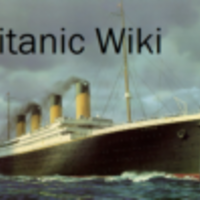John Hardy was the chief steward of second class. He survived the sinking in the last launched lifeboat.
He was the son of John Hardy (b. 1845), a saddler and harness maker, and his wife Sarah (b. 1844). His father was Irish by birth, hailing from Dublin, and his mother a native of Burton-on-Trent, Staffordshire. He had four known siblings: Mary (b. 1869), Walter (b. 1874), Ernest (b. 1881) and William (b. 1882).
John first appears on the 1881 census when he and his family were living a 5 James Street in St Martin in the Fields, London. He would be absent from the following 1891 census and perhaps already at sea; his family were by then living at 42 Ballantine Street, Wandsworth.
The 1901 census shows John, described as a ship's steward, living as a boarder at 68 Gloucester Road, Bootle, Lancashire, the home of a Mrs Anne Lamb and her family. Mrs Lamb's daughter was Harriett "Etta" Morgan Lamb (b. 9 November 1880 in Fishguard, Pembrokeshire, Wales). John and Etta were married on 15 July 1902 in St David's Church, Liverpool and went on to produce two children: Ronald Mortimer (b. 1903) and Norah Mortimer (b. 1905). The family appear on the 1911 census living at Oakleigh, Holyrood Avenue, Highfield, Southampton, Hampshire, perhaps having relocated there sometime around 1907.
John had, by 1912, been working for the White Star Line for twelve years, serving on the Majestic, Adriatic, Olympic, Teutonic and finally Titanic.
He was on board the Titanic for her delivery trip from Belfast to Southampton . When he signed-on again, in Southampton, on 4 April 1912, he gave his address as "Oakleigh", Highfield, Southampton. His last ship had been the Olympic. As Chief Second Class Steward he received monthly wages of £10.
On Sunday 14 April, John retired at 11:50, his room being on E Deck, amidships. He felt a slight shock only a few minutes later. After slipping trousers over his pyjamas and donning a coat he went outside to see what the trouble was. After retiring again, the Chief First Class Steward Andrew Latimer roused him, saying the ship was 'making water forward'. Once on deck, Hardy met Purser Barker who told Hardy to get people on deck with the lifebelts on, just as a precaution. After rousing the stewardesses and assisting unaccompanied women on D, E, and F Decks in putting on their lifebelts, he then assisted in closing the watertight doors on F Deck. Then, going to his assigned station, lifeboat 1, he saw it being lowered just as he arrived. Hardy then went port side and assisted with the boats there, helping Second Officer Lightoller .
He later remembered that, First Officer Murdoch had said to him, "'I believe she is gone, Hardy.' And that was the only time I thought she might sink."
When the last collapsible was just about to be safely launched, Lightoller jumped out to make room for another passenger. Hardy was ordered to stay with the boat, where he also remembered seeing a Quartermaster (Bright), two firemen and about four male passengers, the balance made up of women and children. According to his later testimony, there were no people around to help ready and lower the lifeboat and no women and children in sight.
During the lowering, an American woman took to the boat and her husband jumped into the sea (Mr and Mrs Hoyt). Hardy climbed into the boat once it was on the water. After that
"... We rowed out some little distance from her and finally got together, about seven boats of us... Officer Lowe, having a full complement of passengers in his boat, distributed among us what he had, our boat taking in 10. We had 25 already and that made 35."
...then Lowe returned to pick up survivors. Hardy remained in Collapsible D.
When the Carpathia was sighted in the dawn hours, "...we were towed up by Mr Lowe by sail." After boarding the Carpathia, sometime later, he was surprised to find Lightoller who he had thought had gone down with the ship. From the Carpathia, Hardy estimated there was 5 or 6 miles of ice floe and a number of bergs. Until that time, however, he had not seen any ice. He also added that, to the best of his knowledge, there was no drinking by any of the crew and no means of getting it.
John returned to Southampton and continued working for the White Star Line. During the First World War he served on hospital ships and troop transports and later transferred to working on American Lines during peacetime.
He and his wife welcomed a further two children, twins Joan Etta and Peter, in 1919 and they emigrated in the mid-1920s to the USA, settling in Maplewood, New Jersey, with John working for the United States Line on ships, serving as Chief Steward. He retired in 1936
John was widowed in 1941 when his wife Etta passed away aged 60. He later lived at 71 Gales Drive, New Providence, New Jersey and died in Maplewood whilst visiting his son on 7 October 1953.
Portrayals

In the 1979 film S.O.S. Titanic was portrayed by Jacob Brooke. He only appears after the collision waking up 2nd class passengers, telling them to put on lifebelts. When Leigh Goodwin asks what had happened, he tells that nothing has happened and the requirement to put on lifebelts is a precautionary measure.
